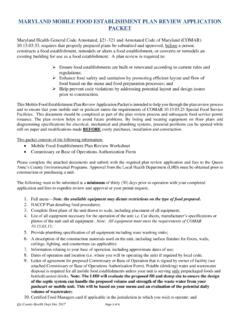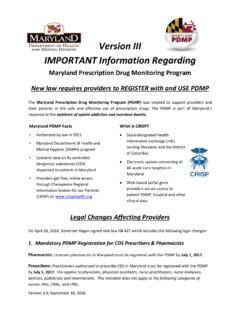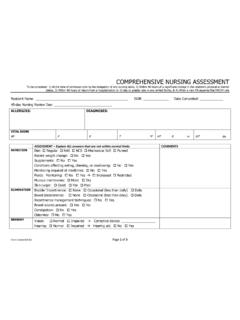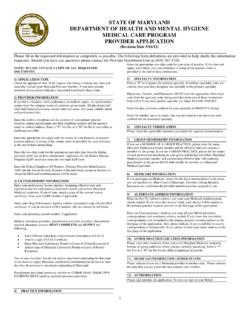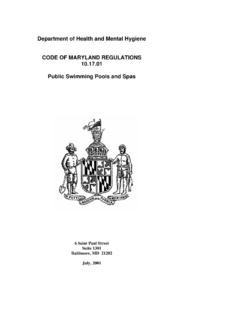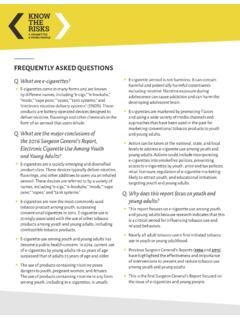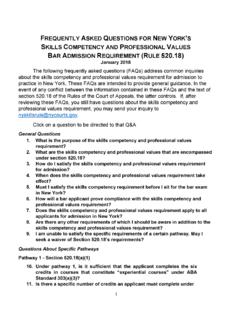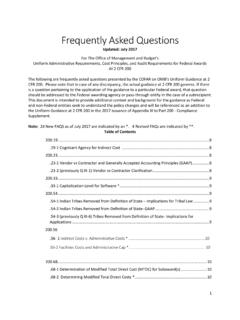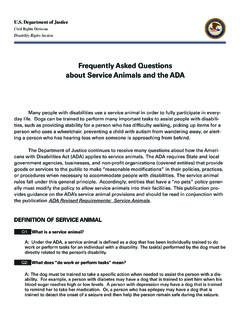Transcription of CPC+ Frequently Asked Questions ... - …
1 CPC+ Frequently Asked Questions Comprehensive Primary Care Plus (CPC+) Frequently Asked Questions December 15, 2016 GENERAL Q: Why is CMS testing CPC+? CMS believes that through multi-payer payment reform and practice transformation, primary care practices will be able to build capabilities and care processes to deliver better care, which will result in a healthier patient population. Payment redesign by payers, both public and private, will offer the ability for greater cash flow and flexibility for primary care practices to deliver high quality, whole-person, patient-centered care and lower the use of unnecessary services that drive total costs of care. Q: When will CPC+ start and how long will it last? Can I join later? The first performance period for CPC+ Round 1 begins on January 1, 2017.
2 CPC+ Round 2 begins on January 1, 2018. CPC+ consists of five performance years, per the table below. CMS expects practices to participate for the full five years of their respective round of the model and will not allow practices to join the model after each round s application cycle. PERFORMANCE YEARS FOR CPC+ Calendar Year Round 1 Performance Year Round 2 Performance Year 2017 1 N/A 2018 2 1 2019 3 2 2020 4 3 2021 5 4 2022 N/A 5 Q: Are practices required to participate in CPC+ for the full five years? CMS expects practices that participate in CPC+ will do so for the full five years of their respective round of the model. However, participation in CPC+ is voluntary and practices may withdraw from the model without penalty during the five-year program period.
3 Practices are required to notify CMS at least 90 calendar days before the planned day of withdrawal. Departing the program before completion of a performance year (PY) puts a practice at risk for recoupment of any uneared CPC+ payments. Q: Where will CPC+ Round 1 be implemented? CPC+ Round 1 will be implemented in 14 regions throughout the : 1. Arkansas: Statewide 2. Colorado: Statewide 3. Hawaii: Statewide 1 CPC+ Practice Frequently Asked Questions 4. Kansas and Missouri: Greater Kansas City Region 5. Michigan: Statewide 6. Montana: Statewide 7. New Jersey: Statewide 8. New York: North Hudson-Capital Region 9. Ohio: Statewide and Northern Kentucky: Ohio and Northern Kentucky Region 10. Oklahoma: Statewide 11. Oregon: Statewide 12. Pennsylvania: Greater Philadelphia Region 13.
4 Rhode Island: Statewide 14. Tennessee: Statewide The CPC+ Round 1 regions were selected based on payer alignment and market density to ensure that CPC+ practices have sufficient payer support to make fundamental changes in their primary care delivery. Q: How is CMS defining the Greater Kansas City (KS & MO) , North Hudson-Capital Region (NY) , Ohio and Northern Kentucky , and Greater Philadelphia (PA) regions? Based on payer alignment and market density, CMS is defining the regions located in partial states with the following counties: Kansas and Missouri: Greater Kansas City Region: Johnson County, KS; Wyandotte County, KS; Clay County, MO; Jackson County, MO; Platte County, MO New York: North Hudson-Capital Region: Albany County, NY; Columbia County, NY; Dutchess County, NY; Greene County, NY; Montgomery County, NY; Orange County, NY; Rensselaer County, NY; Saratoga County, NY; Schenectady County, NY; Schoharie County, NY; Sullivan County, NY; Ulster County, NY; Warren County, NY; Washington County, NY Ohio: Statewide and Northern Kentucky: Ohio and Northern Kentucky Region: All counties in Ohio; Boone County, KY; Campbell County, KY.
5 Grant County, KY; Kenton County, KY Pennsylvania: Greater Philadelphia Region: Bucks County, PA; Chester County, PA; Delaware County, PA; Montgomery County, PA; Philadelphia County, PA. Only practices located in these counties were eligible to apply and participate in CPC+ Round 1. Q: Which payers have been selected to partner in CPC+ Round 1? 1. Arkansas: Arkansas BlueCross BlueShield, Arkansas Health & Wellness Solutions, Arkansas Medicaid, Arkansas Superior Select, HealthSCOPE Benefits, QualChoice Health Plan Services, Inc. 2. Colorado: Anthem, Colorado Choice Health Plans, Colorado Medicaid, Rocky Mountain Health Plans, UnitedHealthcare 3. Hawaii: Hawaii Medical Service Association 4. Kansas and Missouri: Greater Kansas City: BlueCross BlueShield of Kansas City 5.
6 Michigan: BlueCross BlueShield of Michigan, Priority Health 6. Montana: BlueCross BlueShield of Montana, Montana Medicaid, PacificSource Health Plans 7. New Jersey: Amerigroup New Jersey, Inc., Horizon BlueCross BlueShield of New Jersey, UnitedHealthcare 8. New York: Hudson Valley Region: Capital District Physicians Health Plan, Empire BlueCross BlueShield, MVP Health Plan, Inc. Page 2 of 20 CPC+ Practice Frequently Asked Questions 9. Ohio and Northern Kentucky: Aetna, Anthem, AultCare, Buckeye Health Plan, CareSource, Gateway Health Plan of Ohio, Inc., Medical Mutual of Ohio, Molina Healthcare of Ohio, Inc., Ohio Medicaid, Paramount Health Care, SummaCare, Inc., UnitedHealthcare 10. Oklahoma: Advantage Medicare Plan, BlueCross BlueShield of Oklahoma, CommunityCare HMO, Inc.
7 , Oklahoma Medicaid, UnitedHealthcare 11. Oregon: AllCare Health, Inc., ATRIO Health Plans, Inc., CareOregon, Eastern Oregon Coordinated Care Organization, FamilyCare Health, Moda Health Plan, Inc., Oregon Medicaid, PacificSource Health, PrimaryHealth of Josephine County, Providence Health Plan, Tuality Health Alliance, Umpqua Health, Western Oregon Advanced Health, Willamette Valley Community Health Organization, Yamhill Community Care Organization, Inc. 12. Pennsylvania: Greater Philadelphia: Aetna, Independence BlueCross/Keystone Health Plan East 13. Rhode Island: BlueCross BlueShield of Rhode Island, Rhode Island Medicaid, UnitedHealthcare 14. Tennessee: Amerigroup Tennessee, Tennessee Medicaid, United Healthcare, Volunteer State Health Plan Q: Where will CPC+ Round 2 be implemented?
8 CPC+ Round 2 regions have not yet been selected. CMS will solicit interested payers early in 2017, and select and announce the Round 2 regions in late spring or early summer 2017. The CPC+ Round 2 regions will be selected based on payer alignment and market density to ensure that practices have sufficient payer support to make fundamental changes in their primary care delivery. CMS will select up to 10 additional regions in CPC+ Round 2. Q: How does CPC+ Round 2 differ from CPC+ Round 1? The CPC+ model, including model design and practice eligibility, will be the same in Round 1 and Round 2, with one exception: CMS will randomize eligible Round 2 practice applicants, randomly selecting which practices are chosen to participate in the CPC+ intervention group versus the comparison group.
9 Those practices that are not randomized into the intervention group of CPC+ will be placed in a comparison group, and will not receive the CPC+ payments or participate in the learning communities. The randomized trial design of CPC+ Round 2 will strengthen the evaluation of the model. Q: How many practices will be accepted in CPC+ Round 2? CMS plans to accept a maximum of 5,500 practices into CPC+ across both Rounds 1 and 2. Once the final number of Round 1 practices has been announced in early 2017, CMS will release the maximum number of CPC+ Round 2 practices. Q: What is expected of the comparison group practices in CPC+ Round 2? The comparison group practices will not be required to implement the CPC+ care delivery practice changes, will not receive CPC+ Payments, and will not participate in the CPC+ learning communiities.
10 Additionally, they will not be considered participants in an Advanced APM through participation in the CPC+ comparison group, but may otherwise be Advanced APM participants through their participation in other CMS models or programs. Comparison group practices will be compensated for their participation in CPC+ evaluation-related activities and may receive favorable scoring under Improvement Activities category of the Merit-based Incentive Payment System (MIPS) track of the Quality Payment Program. More details for comparison group practices will be announced in 2017. Q: Why will new practice applications only be accepted in new CPC+ Round 2 regions? CPC+ is a voluntary test of primary care payment and delivery system changes at the practice level, and will be independently evaluated throughout the five years of each Round of the model.

